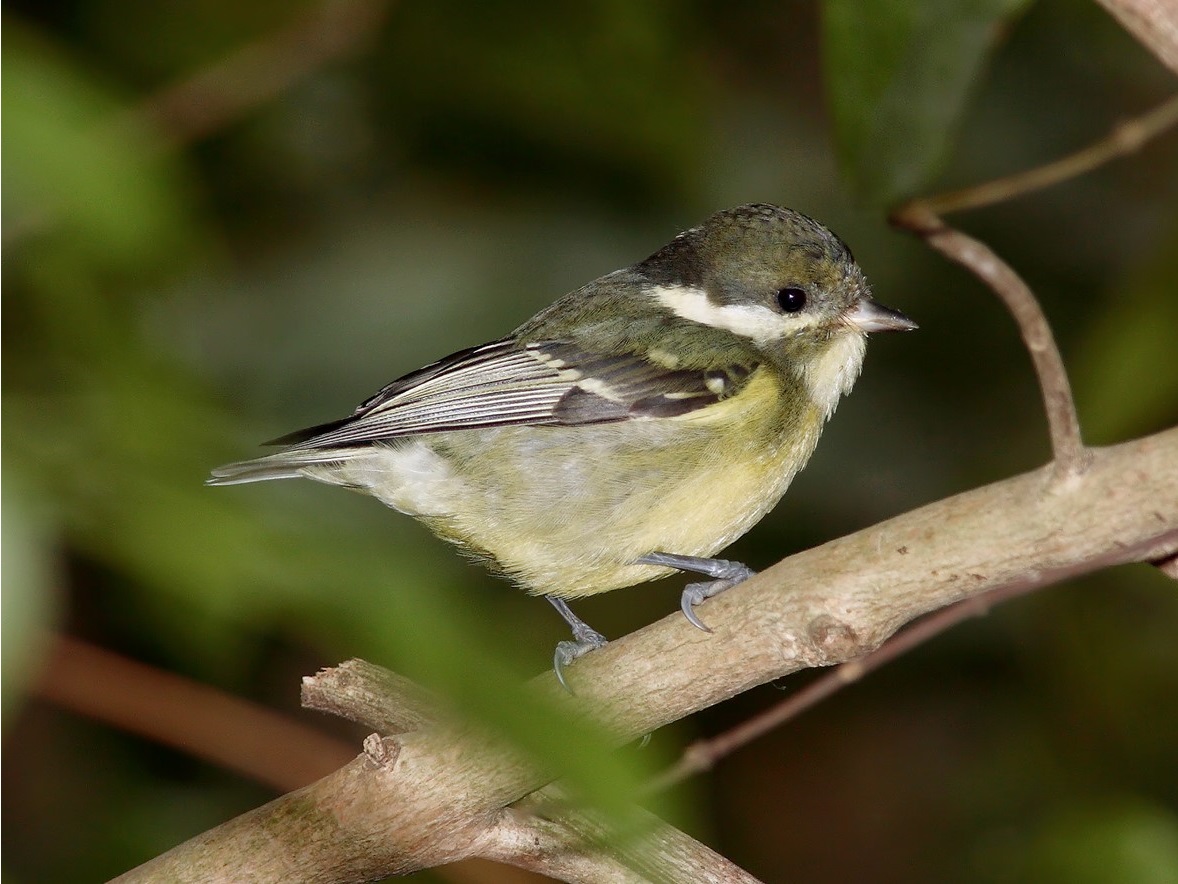Yellow-bellied Tit Pardaliparus venustulus 黃腹山雀
Category I. Irruptive winter visitor with a small number of summer records; numbers have declined since the mid-1980s, possibly a response to milder winters.
IDENTIFICATION

Jan. 2006, Michelle and Peter Wong. Male.
10-11 cm. Small, compact tit with large head, short tail and sharp conical bill. Adult male (illustrated) has dark head, mantle and throat apart from clean white cheek patch, dark flight feathers, tertials and wing coverts, with creamy tips to the latter two and greenish edges to the former, and underparts are tinged yellow.

Jan. 2006, Michelle and Peter Wong. Female.
Female plumage pattern as male but dark grey and blackish replaced by dark olive green. Throat white.
VOCALISATIONS
The commonly heard call is a distinctive three-note (occasionally two), high-pitched, slightly metallic ‘chee-chee-chee’, with the first note usually highest in pitch.
Also other short, high-pitched notes and a nasal ‘chay’.
DISTRIBUTION & HABITAT PREFERENCE
Most records are from areas of mature woodland or large trees. Particularly favoured locations over the years have been Tai Po Kau and the fung shui woods of Lam Tsuen, but records are widespread and transient flocks have also occurred at coastal locations including Tsim Bei Tsui and Mai Po. Birds have reached HK Island in several winters, including a flock of up to 30 which remained in Central for several weeks during the large irruption of 1985-86. There is also a single record from Lamma of up to four birds during November 1990 and one of up to three birds in Sha Tin Park during 20-26 December 2013.
OCCURRENCE
Yellow-bellied Tit was first recorded on 16 November 1969 when a male was found at Tai Po Kau (Webster 1970). Subsequently, it occurred in approximately one year in two, but numbers were highly variable. The pattern of occurrence remained consistent, with most birds arriving in late November or December and smaller numbers remaining through the winter (Figure 1). There are a small number of summer reports from 3 May to 12 September. Since these early reports did not occur in irruption years, it may be that this species is also a true migrant in small numbers, though it is also possible that these records may relate to ex-captive birds. Excluding these, extreme dates are 21 October 1989 and 14 April 1996.
Figure 1 illustrates the pattern of occurrence up to 1998 and since 1999 and indicates that it was much less numerous in the later period, despite the substantially higher level of observer activity this century. The largest irruption was during the winter of 1985-86 (Figure 2), since when no large irruptions have been recorded. Now it is often only two or three birds that are present. As a species that is presumed to irrupt in response to cold weather, it may be that the trend to warmer winters means that irruptions are less frequent.
BEHAVIOUR, FORAGING & DIET
During irruptions birds typically occur in flocks of 20 to 30 birds which may remain in the same area for several weeks; the largest flock, a party of 50, was seen at Tai Mei Tuk on 20 November 1985 (the winter of the largest irruption).
RANGE & SYSTEMATICS
Monotypic. Endemic to China, where it breeds as far west as Guangxi, Guizhou and Sichuan, and as far south as northern Guangdong, while in the north it extends from Gansu east to Hubei and Hebei (but not in lowland areas of the east) (Cheng 1987). At least some birds move southeast toward the coast in winter, sometimes irruptively.
CONSERVATION STATUS
IUCN: Least Concern. Population trend decreasing.
Figure 1.

Figure 2.

Cheng, T. H. (1987). A Synopsis of the Avifauna of China. Science Press, Beijing.
Liu, Y. and Y. H. Chen (eds) (2020). The CNG Field Guide to the Birds of China (in Chinese). Hunan Science and Technology Publication House, Changsha.
Webster, M. A. (1970). Systematic List 1969. Hong Kong Bird Report 1969: 6-39.

